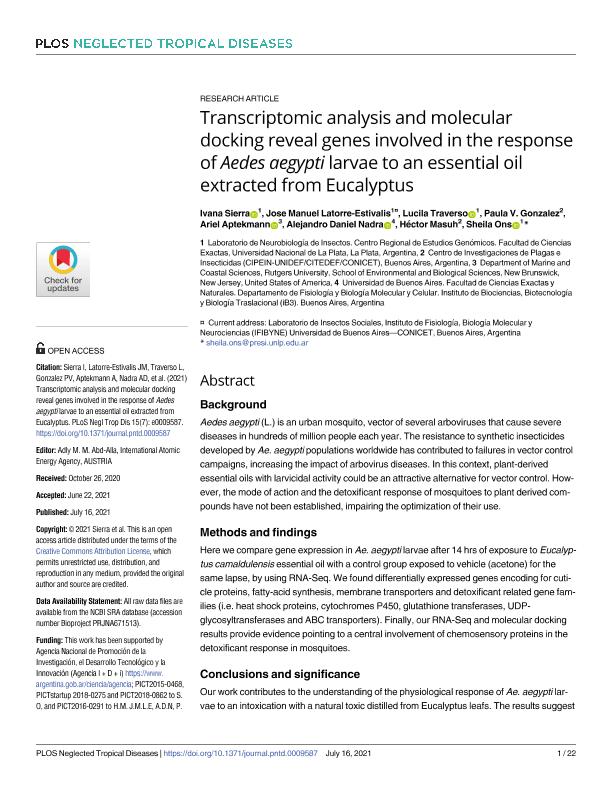Mostrar el registro sencillo del ítem
dc.contributor.author
Sierra, Ivana Samanta

dc.contributor.author
Latorre Estivalis, Jose Manuel

dc.contributor.author
Traverso, Lucila María

dc.contributor.author
Gonzalez, Paula Valeria

dc.contributor.author
Aptekmann, Ariel

dc.contributor.author
Nadra, Alejandro Daniel

dc.contributor.author
Masuh, Hector Mario

dc.contributor.author
Ons, Sheila

dc.date.available
2022-07-19T18:15:38Z
dc.date.issued
2021-07
dc.identifier.citation
Sierra, Ivana Samanta; Latorre Estivalis, Jose Manuel; Traverso, Lucila María; Gonzalez, Paula Valeria; Aptekmann, Ariel; et al.; Transcriptomic analysis and molecular docking reveal genes involved in the response of Aedes aegypti larvae to an essential oil extracted from Eucalyptus; Public Library of Science; Neglected Tropical Diseases; 15; 7; 7-2021; 1-22
dc.identifier.issn
1935-2727
dc.identifier.uri
http://hdl.handle.net/11336/162559
dc.description.abstract
Background: Aedes aegypti (L.) is an urban mosquito, vector of several arboviruses that cause severe diseases in hundreds of million people each year. The resistance to synthetic insecticides developed by Ae. aegypti populations worldwide has contributed to failures in vector control campaigns, increasing the impact of arbovirus diseases. In this context, plant-derived essential oils with larvicidal activity could be an attractive alternative for vector control. However, the mode of action and the detoxificant response of mosquitoes to plant derived compounds have not been established, impairing the optimization of their use. Methods and findings: Here we compare gene expression in Ae. aegypti larvae after 14 hrs of exposure to Eucalyptus camaldulensis essential oil with a control group exposed to vehicle (acetone) for the same lapse, by using RNA-Seq. We found differentially expressed genes encoding for cuticle proteins, fatty-acid synthesis, membrane transporters and detoxificant related gene families (i.e. heat shock proteins, cytochromes P450, glutathione transferases, UDP-glycosyltransferases and ABC transporters). Finally, our RNA-Seq and molecular docking results provide evidence pointing to a central involvement of chemosensory proteins in the detoxificant response in mosquitoes. Conclusions and significance: Our work contributes to the understanding of the physiological response of Ae. aegypti larvae to an intoxication with a natural toxic distilled from Eucalyptus leafs. The results suggest an involvement of most of the gene families associated to detoxification of xenobiotics in insects. Noteworthy, this work provides important information regarding the implication of chemosensory proteins in the detoxification of a natural larvicide. Understanding the mode of detoxification of Eucalyptus distilled compounds could contribute to their implementation as a tool in mosquito control.
dc.format
application/pdf
dc.language.iso
eng
dc.publisher
Public Library of Science

dc.rights
info:eu-repo/semantics/openAccess
dc.rights.uri
https://creativecommons.org/licenses/by/2.5/ar/
dc.subject
AEDES AEGYPTI
dc.subject
ESSENTIAL OIL
dc.subject
EUCALYPTUS
dc.subject.classification
Bioquímica y Biología Molecular

dc.subject.classification
Ciencias Biológicas

dc.subject.classification
CIENCIAS NATURALES Y EXACTAS

dc.title
Transcriptomic analysis and molecular docking reveal genes involved in the response of Aedes aegypti larvae to an essential oil extracted from Eucalyptus
dc.type
info:eu-repo/semantics/article
dc.type
info:ar-repo/semantics/artículo
dc.type
info:eu-repo/semantics/publishedVersion
dc.date.updated
2022-07-15T14:50:04Z
dc.identifier.eissn
1935-2735
dc.journal.volume
15
dc.journal.number
7
dc.journal.pagination
1-22
dc.journal.pais
Estados Unidos

dc.journal.ciudad
San Francisco
dc.description.fil
Fil: Sierra, Ivana Samanta. Consejo Nacional de Investigaciones Científicas y Técnicas; Argentina. Universidad Nacional de La Plata. Facultad de Ciencias Exactas; Argentina
dc.description.fil
Fil: Latorre Estivalis, Jose Manuel. Consejo Nacional de Investigaciones Científicas y Técnicas; Argentina. Universidad Nacional de La Plata. Facultad de Ciencias Exactas; Argentina
dc.description.fil
Fil: Traverso, Lucila María. Consejo Nacional de Investigaciones Científicas y Técnicas; Argentina. Universidad Nacional de La Plata. Facultad de Ciencias Exactas; Argentina
dc.description.fil
Fil: Gonzalez, Paula Valeria. Consejo Nacional de Investigaciones Científicas y Técnicas. Instituto de Investigaciones Científicas y Técnicas para la Defensa. Centro de Investigación de Plagas e Insecticidas; Argentina
dc.description.fil
Fil: Aptekmann, Ariel. Consejo Nacional de Investigaciones Científicas y Técnicas; Argentina. Rutgers University; Estados Unidos
dc.description.fil
Fil: Nadra, Alejandro Daniel. Consejo Nacional de Investigaciones Científicas y Técnicas. Oficina de Coordinación Administrativa Ciudad Universitaria; Argentina. Universidad de Buenos Aires. Facultad de Ciencias Exactas y Naturales. Instituto de Biociencias, Biotecnología y Biología Traslacional; Argentina
dc.description.fil
Fil: Masuh, Hector Mario. Consejo Nacional de Investigaciones Científicas y Técnicas. Instituto de Investigaciones Científicas y Técnicas para la Defensa. Centro de Investigación de Plagas e Insecticidas; Argentina
dc.description.fil
Fil: Ons, Sheila. Consejo Nacional de Investigaciones Científicas y Técnicas; Argentina. Universidad Nacional de La Plata. Facultad de Ciencias Exactas; Argentina
dc.journal.title
Neglected Tropical Diseases

dc.relation.alternativeid
info:eu-repo/semantics/altIdentifier/url/https://journals.plos.org/plosntds/article?id=10.1371/journal.pntd.0009587
dc.relation.alternativeid
info:eu-repo/semantics/altIdentifier/doi/http://dx.doi.org/10.1371/journal.pntd.0009587
Archivos asociados
